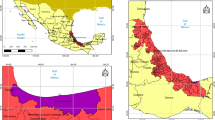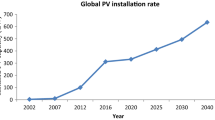Abstract
A computer simulation using MATLAB is investigated to predict the distribution of air stream parameters (humidity ratio and temperature) as well as desiccant parameters (temperature and concentration) inside the parallel plate absorber. The present absorber consists of fourteen parallel plates with a surface area per unit volume ratio of 80 m2/m3. Calcium chloride as a liquid desiccant flows through the top of the plates to the bottom while the air flows through the gap between the plates making it a cross flow configuration. The model results show the effect of desiccant mass flow rate on the performance of the dehumidifier (moisture removal and dehumidifier effectiveness). Performance comparisons between present cross-flow dehumidifier and another experimental cross-flow dehumidifier in the literature are carried out. The simulation is expected to help in optimizing of a cross flow dehumidifier.





Similar content being viewed by others
Abbreviations
- c p :
-
Specific heat (kJ kg−1/°C)
- D :
-
Mass diffusivity (m2 s−1)
- g :
-
Acceleration of gravity (m s−2)
- H :
-
Height of dehumidifier (m)
- h :
-
Height of plate (m)
- L :
-
Thickness of dehumidifier (m)
- M>de :
-
Moisture removal rate in dehumidifier (g s−1)
- m :
-
Mass flow rate (kg s−1)
- P>at :
-
Atmospheric pressure (bar)
- P>w :
-
Wetted parameter (m)
- P>ws :
-
Saturation pressure (bar)
- P>wz :
-
Partial pressure of water vapor in the solution (bar)
- qi :
-
Mixing heat (kJ kg−1)
- u:
-
Velocity (m s−1)
- T :
-
Temperature (°C)
- w :
-
Width channel between two plates (m)
- w>a :
-
Humidity ratio of air (kgH2O/kgdry)
- w>e :
-
Equilibrium humidity ratio of air (kgH2O/kgdry)
- ξ :
-
Solution concentration (%)
- μ:
-
Viscosity (N s m−2)
- ρ:
-
Density (kg m−3)
- α:
-
Thermal diffusivity (m2 s−1)
- δ>s :
-
Solution thickness (m)
- ε :
-
Dehumidifier effectiveness (%)
- λ:
-
Thermal conductivity (W m−1 K−1)
- υ:
-
Kinematic viscosity (m2 s)
- a:
-
Air
- e:
-
Equilibrium
- in:
-
Inlet
- s:
-
Solution
- out:
-
Outlet
References
Liu XH, Jiang Y, Qu KY (2007) Heat and mass transfer model of cross flow liquid desiccant air dehumidifier regenerator. Energy Convers Manag 48:546–554
Liu XH, Jiang Y, Qu KY (2008) Analytical solution of combined heat and mass transfer performance in a cross-flow packed bed liquid desiccant air dehumidifier. Heat Mass Transf 51:4563–4572
Yin Y, Zhang X (2008) A new method for determing coupled heat and mass transfer coefficients between air and liquid desiccant. Heat Mass Transf 51:3287–3297
Dai YJ, Zhang HF (2004) Numerical solution and theoretical analysis od heat and mass transer in a cross flow liquid desiccant air dehumidifier packed with honeycomb paper. Energy Convers Manag 45:1343–1356
Liu XH, Qu KY, Jiang Y (2006) Empirical correlations to predict the performance of the dehumidifier using liquid desiccant in heat and mass transfer. Renew Energy 31:1627–1639
Mohammad AT, Mat SB, Sulaiman MY, Sopian K, Al-abidi AA (2013) Implementation and validation of an artificial neural network for predicting the performance of a liquid desiccant dehumidifier. Energy Convers Manag 67:240–250
Peng SW, Pan ZM (2009) Heat and mass transfer in liquid desiccant air-conditioning process at low flow conditions. Commun Nonlinear Sci Numer Simul 14:3599–3607
Zografos AI, Peteroff C (1991) A liquid desiccant dehumidifier performance model. ASHRAE Trans Part 1(97):650–656
Radhwan MM, Gari HN, Elsayed MM (1993) Parametric study of a packed bed dehumidifier/regenerator using CaC12 liquid desiccant. Renew Energy 13:49–60
Elsayed MM, Gari HN, Radhwan MM (1993) Effectiveness of heat and mass transfer in packed beds of liquid desiccant system. Renew Energy 3:661–668
Kinsara AA, Elsayed MM, AI-Rabghi OM (1996) Proposed energy-efficient air-conditioning system using liquid desiccant. Appl Therm Eng 16:791–806
Yin Y, Zhang X, Chen Z (2007) Experimental study on dehumidifier and regenerator of liquid desiccant cooling air conditioning system. Build Environ 42:2505–2511
Moon CG, Bansai PK, Jain S (2009) New mass transfer performance data of a cross-flow liquid desiccant dehumidification system. Int J Refrig 32:524–533
Mesquita LCS, Harrison SJ, Thomey D (2006) Modeling of heat and mass transfer in parallel plate liquid-desiccant dehumidifiers. Sol Energy 80:1475–1482
Bassuoni MM (2011) An experimental study of structured packing dehumidifier/regenerator operating with liquid desiccant. Energy 36:2628–2638
Author information
Authors and Affiliations
Corresponding author
Rights and permissions
About this article
Cite this article
Mohammad, A.T., Mat, S.B., Sulaiman, M.Y. et al. Theoretical study of the effect of liquid desiccant mass flow rate on the performance of a cross flow parallel-plate liquid desiccant-air dehumidifier. Heat Mass Transfer 49, 1587–1593 (2013). https://doi.org/10.1007/s00231-013-1198-8
Received:
Accepted:
Published:
Issue Date:
DOI: https://doi.org/10.1007/s00231-013-1198-8




